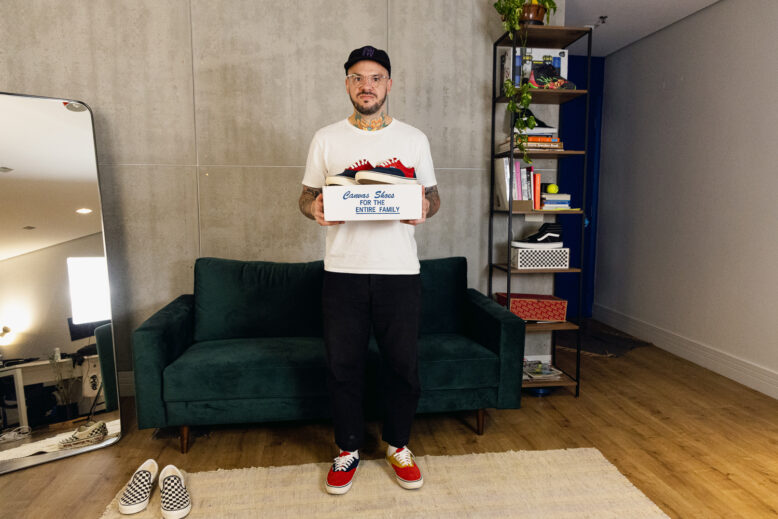
Myles discusses his fascination with how things are made, his experience working on projects like the ‘The Ten’ Off-White collaboration with Nike, Raf Simons footwear, and the technicalities of footwear manufacturing. Myles emphasized the importance of purpose in product creation and shared his vision for Areté, to expand into other areas of product creation and manufacturing.
Photos: Kickstory
Color Grade: Julio Nery


“My name is Myles O’Meally, I’m from Birmingham, in the UK. I’m the founder of Areté, a product design and engineering studio based in Amsterdam. Currently we specialize in the creation of footwear, but in the future, we’re going to move into other product areas as well, outside of footwear. Before I started the studio, I was at Nike for five years as a footwear developer. I spent two years in the Netherlands, and then three years in Vietnam, working in their factories. At the end of 2018 I decided to leave Nike, and in 2019 I started Areté.”
How was the transition from a promising tennis career to focus on product design engineering?
myles From the age of 5 to 20, for 15 years, I just played tennis, that was my thing. I wanted to become a professional tennis player. So I played, trained every day, tournaments and traveling. As a junior I had an international ranking, in the UK I was top 25.
It was amazing because the mindset that you build playing sports at a high level, is an applicable mindset that you can transfer into many other walks of life. So for me, it was an amazing experience to play tennis, travel and have that competition in your life from a young age, but also the characteristics and the mindsets that you develop through that period are priceless. I still use it today.
When I got into seniors, and that was my first pro year, the jump up was just crazy. The level is so high. And still, you’re not really making a lot of money. So I thought: “How many more years have I got of training, growing to get to that level, where I can make a living out of the sport?”. And it just didn’t make sense to me. So I decided to just stop and then look at the other areas of my life that I was very interested in: product design engineering and graphic design.
Since I was a kid, I’ve always been fascinated by just understanding and learning about how things are made. I wanted to find a study that connected these two passions: sports and product design engineering. I did a course in Sheffield called Sports Technology, and then I did a master’s year in Engineering Design. That was the year that really accelerated my thinking and I changed a lot. That master’s degree was the qualification that got me my job at Nike.
“It was amazing because the mindset that you build playing sports at a high level, is an applicable mindset that you can transfer into many other walks of life”

When you decided to do industrial design, did you have in mind what you wanted to work with?
myles Yeah, hard goods equipment like rackets, shin guards, and protective equipment. I liked the idea of being involved in making products that the athlete uses to perform with. Shoes are obviously definitely that, so that’s one of the reasons why the job with Nike in footwear was so appealing. I never did anything on footwear in my studies, not one class before my job at Nike. Which goes to show to me how transferable the engineering design skills are across product categories.
When I stopped playing tennis, it was like: “If I’m not going to be the pro athlete myself, let me at least be involved in the industry by creating the equipment that helps the athlete.” I understand what the athlete wants on the equipment because that was me. So, let me transition to the other side of it and be the maker of it.


What products did you first work on at Nike?
myles The product I worked on was a nice place to begin because it wasn’t overly technical to understand. I worked in the European headquarters here, in Hilversum, and the team was called “Western Europe Product Creation”. So, we created products for this region. Special packs for London, special products for key accounts like size? and Footlocker. We didn’t do any new creation, toolings or new uppers. The way that an Air Max 1 would look for the North American consumer, wouldn’t necessarily be the same for the Western European consumer. We’d have to tweak it a little bit, with colors, materials, prints, graphics and storytelling. We had existing styles, existing silhouettes, and we basically would make it appropriate for our consumer group in Western Europe, whether that be Berlin, London, Paris or whatever.
That’s what I was doing in the first two years. It was a nice mix of consumer, culture, and industry with the physical process of making footwear. It was a good way to begin learning about footwear.
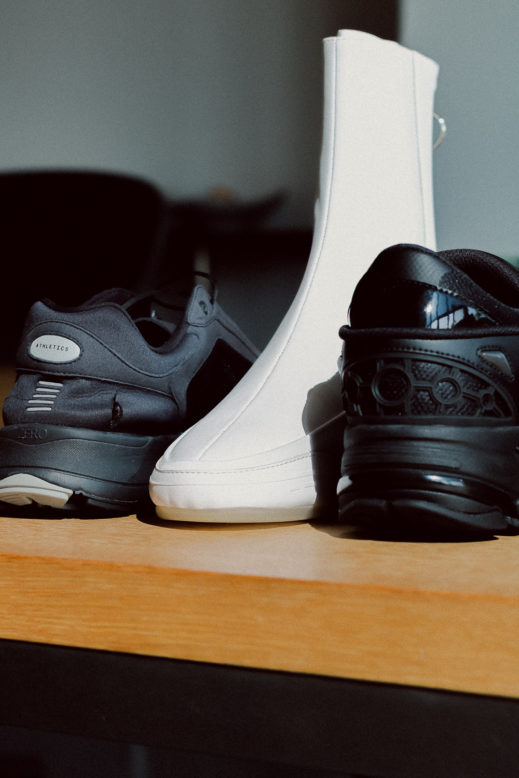

You went from working at the office, with the creation team in Europe, to working in Vietnam in the factories seeing how products were made in real time. How was that experience for you?
myles I personally loved it. As I said, my background is in design engineering. The fascination I had with how things were made, now I’m in the heart of it. That’s where I geeked fully out, I nerded hard all over that shit. It was obviously different in Vietnam, culturally, it’s night and day. Now, it’s actually quite cool to see how the scene in Saigon has developed. There were definitely tough moments, but just the geeky side of me was cool with what I was there for. I loved going into the factories each day and just working on a product, learning how it was made.
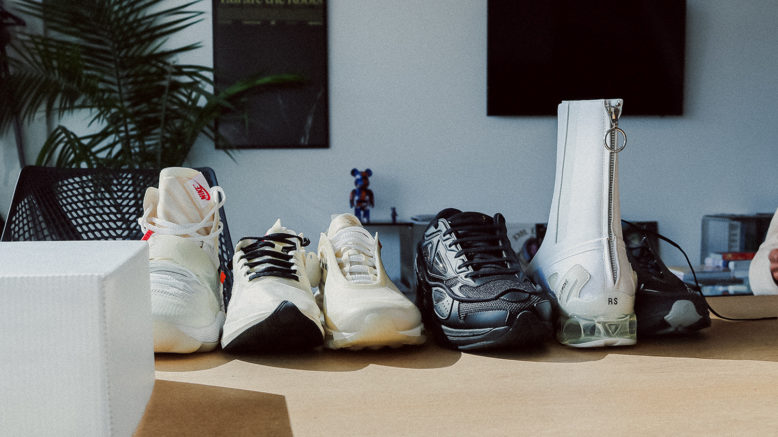
And what kind of product were you working on in Vietnam?
myles Nike sends you in a three-year expat contract and you mainly work on one product category. In my first year I worked on core performance running, which is all running shoes under $100. And it’s obviously cool to learn how to make technical shoes at a lower price point because you have to really dig into the shoe, and learn a lot about how it’s made.
But then, after one year, I’m like: “I can’t do another two years of making the same shoe again.” So, I said to my boss: “It makes no sense. You’re actually wasting your investment on me by putting me here, and asking me to learn how to make only one type of shoe. I’m here for three years, let me learn how to make all types of shoes”.
So my boss said he would try and get me some lifestyle stuff because he could see I was very knowledgeable, and interested in that side of the industry too. A few weeks later, he’s like: “There’s this Off-White collaboration. I’ll put you down to manage the projects.” Obviously I was very excited, and that’s how I got the Off-White project. Ps.: he had no idea what Off-White was.
All of the “The Ten” shoes were made in China, except for three shoes that were made in Vietnam: the Air Max 97, the Zoom Fly, and the Hyperdunk. And that’s just what I worked on for the next eight months.
“All of the ‘The Ten’ shoes were made in China, except for three shoes that were made in Vietnam: the Air Max 97, the Zoom Fly, and the Hyperdunk. And that’s just what I worked on for the next eight months.”


How was it for you to work on such technical shoes with so many details and different materials?
myles I loved it. When I worked with core performance running, as an engineer, I needed to really get into the shoe because it’s 1.5 million pairs of shoes made in one style. If you can save Nike five cents on that shoe, times 1.5 million units, it’s a lot of money. They really pressure you as a footwear engineer to break up the shoe and understand how it’s made to save two, three cents on some patterning or material.
Then, I had the chance to implement the stuff I’d learned the year before into a product where price was not an issue. I could just do it. I’d be like: “Y’all, but if I do it this way, it’s going to cost x,” and the Portland design team would be like: “Myles, don’t worry about the price. Just make it how we want it to be made”. That was amazing. I could just be really creative as an engineer, which was really fun.
“Then, I had the chance to implement the stuff I’d learned the year before into a product where price was not an issue. I could just do it. I’d be like: ‘Y’all, but if I do it this way, it’s going to cost x,’ and the Portland design team would be like: ‘Myles, don’t worry about the price. Just make it how we want it to be made’. That was amazing. I could just be really creative as an engineer, which was really fun.”
Do you have other projects that you worked on that you also really like?
myles At Nike, the Off-White stuff was really cool, but honestly, the most enjoyable and interesting product I worked on for me was when I went into what Nike called “cleated” during my last year. It is so highly technical, and half a millimeter makes a big difference. It’s kind of close to that hard goods thing I had at the beginning. I just like when you have to open a mold for something. The moment you have to open a mold and engineer it, I’m like, okay, let’s go.
And in football, it’s just so precision-based. American football boots as well, depending on the player’s position; if he’s a wingback, he’s sprinting; of course he wants light boots, almost like English football boots. But if he’s like one of the big boys in the middle, he needs these big ass protective boots built with armor all over it. So my most enjoyable and interesting category was the cleated for sure.

And what made you leave Nike and start your company?
myles For the whole of 2018, I was trying to find a place in Nike where I could play multiple roles, or at least be involved in some capacity in multiple areas. Because Nike is such a big company, it needs to be highly structured, so everyone has their lane that they sit within.
I moved to Vietnam at 26, so you’re in a factory for Nike from 26 to 29. In their eyes, now you’re going to become that guy for them. It’s so unique to have that experience. So, now they want you to grow in that area and I didn’t want to only do that. The alternative they were giving me was to switch to a completely different category, like a product line manager or something. But I still wanted to engineer, but not only engineer. So that’s why, eventually, it became apparent that we weren’t going to find a meeting point. My contract naturally came to an end in December 2018, and I just didn’t renew it.

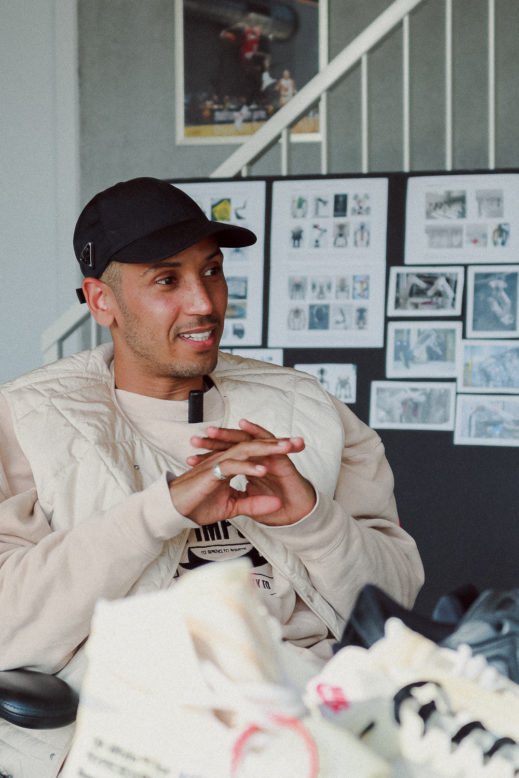
What made you want to create your own brand, Areté? And what was the idea behind it?
myles July 2019 is when it officially began. Originally, Areté was an idea that I pitched to Nike: to build a satellite team of creatives, strategists, engineers, product people, and consumer people. And they would basically move around Europe and work on these collaborations, work on projects within Europe. I was pitching this idea to VPs, but I was just too junior at the time; I needed probably five or six years for my idea to have any kind of conversation afterward.
I took that idea and decided I would build it myself. It’s really about removing the barriers in the industry. And then it evolved into “How can we be more purposeful in the way we create and what we create?” and that’s actually how I came to the name Areté – it’s a Greek word, and it means fulfillment of purpose; it’s a way to live your life, that utmost respect and focus. Having true fulfillment in everything that you did would be a life of a Areté.
The company was basically built off the back of that idea, and it turned into being a platform that removed the barriers in a complex industry, creating in a purposeful way. Making footwear is incredibly difficult – it’s super technical, supply chain is mad, production facilities are hard to get into, the costs are very high, knowledge is very exclusive, it’s just a very difficult product category to get into. In everything that we do, we try to focus more on the process rather than the end product.
“The company was basically built off the back of that idea, and it turned into being a platform that removed the barriers in a complex industry, creating in a purposeful way. Making footwear is incredibly difficult – it’s super technical, supply chain is mad, production facilities are hard to get into, the costs are very high, knowledge is very exclusive, it’s just a very difficult product category to get into. In everything that we do, we try to focus more on the process rather than the end product.”
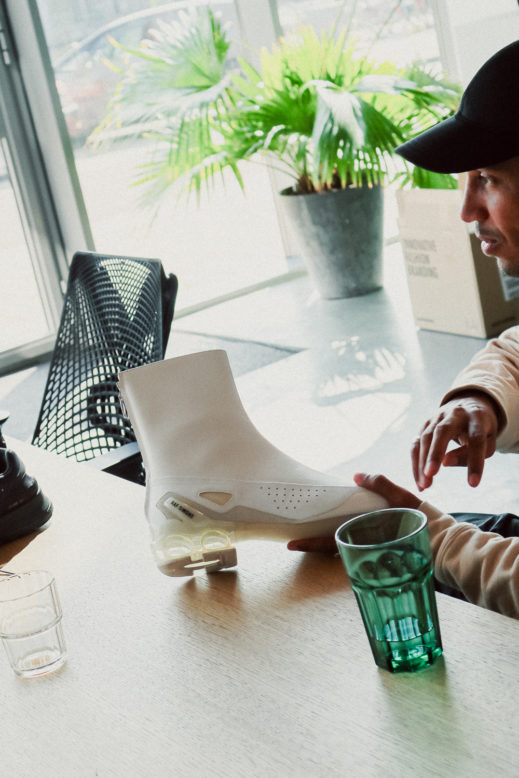

You have done work for big names and huge brands, and done amazing products, but how did you land your first client?
myles It starts obviously with Raf Simons, and that’s just very lucky; it’s purely the right place at the right time. When I moved back, I was plugging back into my networks through Europe, just connecting with my people again. One of the guys who I bumped into in Soho House in Amsterdam told me: “You need to talk with this guy in London, called Chris Kyvetos“. Chris is one of those behind the scenes key players who has been pulling strings in the industry for well over a decade and the founder of Athletics FTWR, a brand I also now work with him on building.
We met in London early 2019 and hit it off. Less than a month later her rang me and said – “Raf Simons wants to start his own footwear line; I put your name forward. Go to Antwerp and meet him”. That’s how I got Raf. It was through Chris.
We obviously got very lucky because Areté’s first project with Raf was the 2020 Paris Fashion Week, literally two months before COVID began. But he did his runway; all the press was there, taking the pictures, and the footwear, of course, was a big part of that write-up. We got a lot of media from that, and that gave me everything else for the next year: MCQ, Stone Island, and A-COLD-WALL*. These projects came off the back of that media attention.
“We obviously got very lucky because Areté’s first project with Raf was the 2020 Paris Fashion Week, literally two months before COVID began. But he did his runway; all the press was there, taking the pictures, and the footwear, of course, was a big part of that write-up. We got a lot of media from that, and that gave me everything else for the next year: MCQ, Stone Island, and A-COLD-WALL*. These projects came off the back of that media attention.”

When a client comes to you for a project. What's the process from creating, to manufacturing the end product?
myles The process, in an ideal world, is that the client comes to us with a need, what they’re trying to do in footwear, what they’re trying to create, and what their objective is. And now we always challenge very deeply on the purpose, what is the ‘why?’. For us to be able to see that, we’ve realized and learned a lot over the last three years.
Sometimes, we send a series of questions to really understand and get them thinking: “Why are we doing this?”. Once we’ve established the purpose, we can go through a research period where we research that subject, that topic, to help build on that purpose, to help provide some meat that can support and help us design to that purpose and solve that problem.
Concepting after that is just taking those findings through research and starting to build some tangible ideas. Through the research and design phase, it’s always a very close touch point with the client, and there’s constant back and forth. It’s not just us doing the thing and showing it to them. Quite often, there’s communication; During the concept phase, we also physically build things as well, not just sketch. We make mock-ups with the sewing machine, gluing, stitching, and cutting.
That’s also something we learned over the last three years, that we can not only rely on sketches to share concepts and ideas. Often the client struggles to understand the real world form of the design, the 3D nature. Because of this we have adapted the concept process to also share physical concepts and 3D models and print outs. We find this is the best way to express concepts and ideas to clients. Once the concept is approved we can proceed to the final design stage where we will create a tech pack to send to our factory partners. Then the sampling period can begin, which can take anywhere between 6 to 18 months, depending on the complexity of the product.


And what is it about the Raf Simons Cycloid-4 boot that you like so much?
myles I really like this Cycloid-4 boot because it’s a true fusion of everything that Raf’s footwear aspired to be. It’s a real fusion of past eras and past forms, combining with future technologies and future mindsets. He was really just clashing these two worlds together throughout all of his products in footwear. That’s what he’s very good at. And for me, this is the best shoe we did in the three years for Raf Simons, that really hit that ID on the head because under all that, it’s a very classic boot. The reference is a Renaissance Victorian boot in terms of shape and slenderness, but you’ve got the sports nylon and this crazy injected plastic heel, which is used more in football boot plates, and this kind of thing.
This kind of mold is super expensive, very technical, and the detailing on the sole as well. This, for me, has just got so much interesting information, and the execution of it is done so well. But when it comes to the build, material mix and the technicality of the tooling, how that’s made – I know how complex the mold is for this kind of sole, it’s why I love this boot.
It’s a perfect mix between this Renaissance, early 1900s era footwear, clashing that with the 2030 modern-day techniques, engineering techniques and model-making techniques that are not necessarily used in this kind of product. In many ways, for me, it was ahead of its time because it is super futuristic. So that’s one of my favorite products that our studio has done today, for sure.
“I really like this Cycloid-4 boot because it’s a true fusion of everything that Raf’s footwear aspired to be. It’s a real fusion of past eras and past forms, combining with future technologies and future mindsets. He was really just clashing these two worlds together throughout all of his products in footwear. That’s what he’s very good at. And for me, this is the best shoe we did in the three years for Raf Simons, that really hit that ID on the head because under all that, it’s a very classic boot.”
What are the plans for Areté in the future?
myles To do footwear better. We’ve now got a recalibrated process that we work through as a team. We also have some new projects that take us into new spaces, apparel design, accessory design, interior/spatial and object design. With these projects, I’m really trying to open new doors for us as a studio to expand product creation and manufacturing outside of just footwear. But manufacturing is still going to be an important part of our studio – to be able to physically create the things that we design.
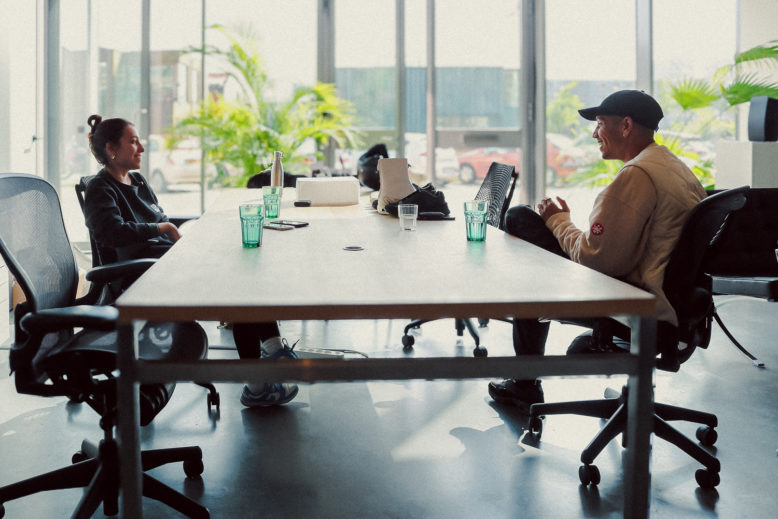
It takes a lot of courage to step away from the work you were doing at Nike, and open your own company, which works with something so difficult and complex as footwear. Do you have any advice for people who wish to start their own company, and build their own thing?
myles You definitely have to learn quickly in the sense that you can’t make the same mistake too many times. You’re going to make them, and you need to make them to learn, evolve and grow. You definitely have to be kind to yourself through the early stages of the journey but still hold yourself to a high standard. It’s a fine balance.
You need a lot of patience and faith in the process. Nothing happens overnight, so you have to really believe, step by step, that you’re doing the right thing. I saw this one tweet from Steven Bartlett, from Diary of a CEO, which was something like: when you plant a seed, you don’t constantly go back in and dig it up to see if it’s growing, right? You plant the seed, you water it, you feed it, you nourish it, you take care of it, you move it in the right environments, and you just have faith that you’re doing the right things for that seed to grow into a tree or whatever it may be. You’re not constantly digging it up to see if it’s grown.
Have faith in yourself and your process. Just believe and keep positive with that.
“You definitely have to learn quickly in the sense that you can’t make the same mistake too many times. You’re going to make them, and you need to make them to learn, evolve and grow. You definitely have to be kind to yourself through the early stages of the journey but still hold yourself to a high standard. It’s a fine balance.”
